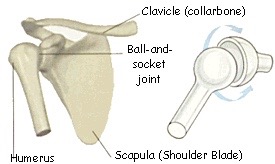In Essentrics, we sculpt the muscles and stress the bones but also condition the joints. One distinctive feature about Essentrics is the large, continuous, circular movements throughout the routine. They have roots in tai chi, ballet, and physiotherapy. We feel natural, pleasant, and incredibly good doing them because they work our joints the way the joints should work. Our bones are connected through movable and immovable joints. The joints in our skull, for example, are rigid and immovable. In Essentrics, we are concerned with movable, synovial joints. These joints are filled with fluid to reduce friction, much like oiled engine parts, and defined for specific motions. A typical example is the ball-and-socket joint. It is the most important and powerful type of joint because of its range of motion. Try making a fist with one hand and cup it with the other. The fisted hand can rotate with a great degree of mobility. Our arms and legs connect to the skeleton through ball-and-socket joints, and therefore enjoy a greater range of motion. The top end of the arm bone or humerus, for example, is a ball shape that inserts into the cavity in the scapula, or shoulder blade. We can swing our arms and legs in circles. If we don’t use these ball-and-socket joints to their full capability, if we don’t rotate them sufficiently, deposits will build up and the joints will become rigid. The muscles around the joints work together to make those large, circular motions and will also become stiff from fascia build up. Fascia is the film-like connective tissue that can harden from lack of movement. Joints and mobility are a classic case of “use it or lose it. This explains why those circular movements in Essentrics feel so natural and pleasant. We are moving those joints and the surrounding muscles the way they can and should move. In one of our popular trademark movements “Caribbean Spine,” we rotate the arms and the entire shoulder joint. When we lift our elbows to shoulder height and pull forward we are also stretching and lengthening the upper back muscles such as the trapezius and the rhomboids. When we open and rotate the shoulder backwards we work the pectorals. The motion therefore not only conditions the joints but also improves our posture by increasing flexibility in the upper back and chest. This is the beauty of Essentrics’ economy and efficiency.
When we do the “Clock Kicks” with our legs, we keep the body steady, then isolate, kick and travel one leg around from front to back and vice versa. This is also a simple, powerful, and effective move. Many people find this circular motion challenging because they can’t isolate and lift their legs at all angles. While most have no trouble lifting the leg forward and up, for example, doing so on the side and to the back can cause many to wobble and lose balance. The motion reveals the weakest muscles in the hip and leg areas as well as rebalances them. When we unclog this ball-and-socket joint connecting the legs, we are also improving mobility and enhancing our balance. This is why static stretches and holding poses do relatively little to condition our joints, which need movement. Traditional weight lifting, involving rigid, mechanical motion, stresses bones but doesn’t work the ball-and-socket joints to their full range. Pushups and tricep dips can build and tone muscles quickly but can overload the wrists. Similarly, holding poses such as the downward dog position in yoga can stretch the latissimus dorsi in the lower back as well as the hamstrings in the legs, but can put too much pressure on the compressed wrists. Then there is the question of impact. Certain sports such as tennis and volleyball involve full rotation of the one arm, but not both. Yet the movements also involve hitting a target which impacts the joint.
1 Comment
|
Categories
All
Archives
July 2024
AuthorAmanda Sterczyk is an international author, Certified Personal Trainer (ACSM), an Exercise is Medicine Canada (EIMC) Fitness Professional, and a Certified Essentrics® Instructor. |


 RSS Feed
RSS Feed